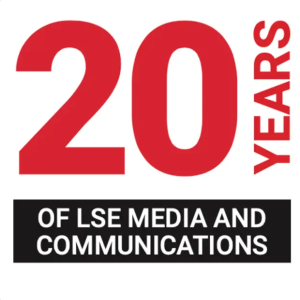 LSE’s Department of Media and Communications celebrates its 20th anniversary in 2023, and recently marked the occasion with the Media Futures Conference held on 15-16 June. To celebrate the Department’s contribution to media and communications research and teaching over the last 20 years, we are publishing a series of reflections from faculty. Here, Professor Sonia Livingstone explains the origins of Media and Communications at the LSE: to hear more from Sonia and Nick Anstead on this topic, do listen to our podcast episode ‘The History of Media and Communications at the LSE’ available here on your preferred podcast platform.
LSE’s Department of Media and Communications celebrates its 20th anniversary in 2023, and recently marked the occasion with the Media Futures Conference held on 15-16 June. To celebrate the Department’s contribution to media and communications research and teaching over the last 20 years, we are publishing a series of reflections from faculty. Here, Professor Sonia Livingstone explains the origins of Media and Communications at the LSE: to hear more from Sonia and Nick Anstead on this topic, do listen to our podcast episode ‘The History of Media and Communications at the LSE’ available here on your preferred podcast platform.
I arrived at LSE’s Department of Social Psychology (as it was then) in 1990, full of excitement about growth of media and communications and cultural studies, following my doctoral research on how audiences make sense of television, and having worked with Roger Silverstone at the Centre for Research into Innovation, Culture and Technology (CRICT) at Brunel University.
In 1993, I began the MSc Media and Communications with Tom Nossiter and Rosie Gosling in the Government Department. That’s one place to start the story of media and communications at LSE. But, of course, there could be other starting points. For example, Hilde Himmelweit and colleagues had published “Television and the Child” in 1958, and academics in other departments had also variously written about – and participated in – the mass media. But this was largely as a matter of individual research choices, not formal teaching, nor a collective endeavour within or across departments.
As a field, media and communications was therefore not visible at LSE, though it was already flourishing nationally and internationally. In the UK, media studies had emerged from the fertile intersection of literature and critical sociology, led by Raymond Williams, Richard Hoggart, Stuart Hall and others at the Birmingham Centre for Contemporary Cultural Studies, with different centres of expertise in the form of the Glasgow University Media Group, and the Centre for Mass Communication Research led by Jim Halloran at the University of Leicester. In the USA, the field of ‘communication’ was the dominant influence internationally, though its more administrative rather than critical orientation impeded links with developments in the UK or, for example, Latin America.
But it was a time of disciplinary change at LSE – and enthusiasm about the new prospects for research, teaching and intellectual exchange opened up by interdisciplinarity: for instance, we were setting up the Gender Institute (now the Department of Gender Studies) at the same time, as well as the European Institute. In our favour, the importance of all things media and digital was becoming ever more obvious and the imperative for critical examination of “new media” was pressing within and beyond the academy – with new journals, books, courses and conferences springing up internationally.
Indeed, there was a lot of optimism about the democratising potential of the internet – recall those early debates about citizen journalism, digital literacy, global communication networks. At the same time, concerns over the digital divide, media imperialism and online risks to children quickly rose up the agenda. Conceptually, the academy struggled to bring together siloed traditions of research on interpersonal and mass communication, and the ferment in the field was still raging.
Nonetheless, creating a new master’s programme at LSE in the early 1990s was a case of making stone soup, since no resources were allocated to it. Anyone who I could persuade to contribute to the Theories and Concepts in Media and Communications course did so. In that first year, we had lectures from Alan Swingewood and Leslie Sklair from Sociology, Robert Reiner from Law, Peter Loizos from Anthropology, Geoffrey Stern and Fred Halliday from International Relations, along with Tamar Liebes as visiting faculty.
The result was simultaneously exciting and somewhat shaky – with the Specialist Group in Media and Communications at the University of London (which had the final say in those days) giving us a hard time before approving the programme, and LSE getting cold feet and trying to close us down before we got started. Informally, the slur about media studies as a Mickey Mouse subject was alive and well in elite circles.
But the enthusiasm from students – the programme recruited strongly from the start – buoyed us up. The Department of Social Psychology invested in the programme, for instance, appointing Richard Collins and Maggie Scammell. And the LSE Media Group, chaired by David Kingsley and animated by Mark Stephens and Loyd Grossman, put their energies behind us too, inviting students to alumni events and fostering relations with the professional world of media and communications.
LSE remained sceptical for a good while – was the student market sustainable, could we do excellent research, was this new-to-LSE field of genuine intellectual value, were we a reputational risk to LSE, could we be financially viable, would we undermine our host departments by separating from them? Institutionally, we passed all the tests set us – earning an ‘excellent’ in the Teaching Quality Audit, putting on a Summer Programme from 1997, and starting a Media Research Group to coordinate research across LSE.
It made a huge difference, however, when Roger Silverstone came from Sussex University to become LSE’s first professor of media and communications in 1998. New programmes followed – the MSc in Global Media and Communications with USC, directed by Terhi Rantanen from 2000, and the MSc New Media, Information and Society, directed by Robin Mansell from 2001. Nick Couldry joined in 2001 also – we were becoming a critical mass, already punching above our weight! By now, too, our first PhD students were emerging – many of whom are now full professors around the world, making the continued case for media and communications.
Having formed ourselves into Media@LSE in 1998 (those were the early days of ‘@’), we began mapping a deliberately interdisciplinary research agenda and advocating for a new department. The intellectual climate was already shifting – now heavily shaped by globalisation, optimism about cosmopolitanism and digital democracy, though there were also plenty of genuine problems arising, as well as a host of moral panics. We sought to be media-centred not media-centric nor technologically determinist. We put on courses about culture, audiences, representations, everyday life, political economy and regulation. We talked about processes of mediation, media literacy and social change – including changing forms, genres, practices, institutions, audiences (as users, citizens, consumers). We tried to find ways of engaging with stakeholders outside the academy while always thinking critically, always focused on power, to build a normative agenda for the public good.
So, with the support of LSE’s then director, Anthony Giddens, the department was formed in 2003 – the first new department for some 40 years. I will never forget attending that Academic Board where we sat in an anxious row, as if at a wedding, holding our breath for objections from any persons here present…
My colleague Robin Mansell picks up the story from here, and other colleagues have added their recollections on this blog too. It has been my pleasure to write the prequel to the department’s founding, extending our 2023 #MediaFutures celebration from 20 to 30 years!
 To hear more from Sonia in conversation with Nick Anstead, do listen to our podcast episode ‘The History of Media and Communications at the LSE’ available here on your preferred podcast platform.
To hear more from Sonia in conversation with Nick Anstead, do listen to our podcast episode ‘The History of Media and Communications at the LSE’ available here on your preferred podcast platform.
This post represents the views of the author and not the position of the Media@LSE blog nor of the London School of Economics and Political Science.




